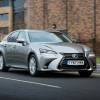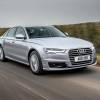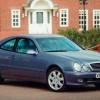
RAC sale – up to 33% off*
• Roadside cover from £5.29 a month†
• We get to most breakdowns in 60 mins or less
• Our patrols fix 4/5 breakdowns on the spot

By Andy Enright
Introduction
It's difficult to consider the Mercedes-Benz C-Class in isolation. This is a car that's inextricably linked to two other vehicles, the BMW 3 Series and the Audi A4. Whenever one of these models steals a march on the other pair, there's a furious scuffle to reclaim lost ground. Unfortunately for Mercedes, it has found itself in the position of playing catch up too often, and the C-Class sits on the third step of this particular podium, in UK sales at least. On the Continent, it's a different story and the Mercedes puts a sound leathering on the A4 and even outsells the 3 Series in some markets. The third generation C-Class has always been a popular pick with used buyers. Here's how the late facelifted versions of this car stack up.
Models
4dr saloon, 5 dr estate (2.1, 3.0 diesel, 1.6, 1.8, 6.2 petrol [Executive SE, AMG Sport, AMG Sport Plus, AMG])
History
The year 2007 was pivotal for Mercedes. This was the time that, after fourteen years in the shadow of the BMW 3 Series, the C-Class finally stepped out and asserted itself. For so long, too many aspects of the C-Class had been a copy of BMW's strategy, yet it felt like a car without a great deal of personality that was leaning on rather than enhancing that three-pointed star. In March of 2007, we got the W204 version, the third generation C-Class, and it delivered a return to reassuring quality and driver appeal. Stuttgart was back in the game.
Fast forward to July 2012 and Mercedes had enjoyed over five years of solid service from the C-Class. It decided to offer it a light refresh for the last couple of years of its life. In came a more efficient 1.6-litre turbocharged petrol engine at the base of the range, while the mighty 6.2-litre C63 AMG remained unaffected by the 2012 model changes. This most modest of facelifts lasted the C-Class through to its 2014 replacement with an all-new car.
What You Get
The 2012 refresh wasn't the most extensive piece of remedial design, but then it didn't need to be. The C-Class's lines had aged well and the technology had been incrementally improved throughout the car's life. There were new interior and exterior features, including revised colour options, repositioned cruise control and indicator stalks and easier-to-read silver graphics for the telematics screen. The telematics system in conjunction with Mercedes-Benz COMAND now included eCall to report the car's position to a call centre via GPS in the event of an emergency.
The revised trim structure started with Executive SE and then ascended to AMG Sport and AMG Sport Plus, with the C63 AMG saloon and estate sitting somewhat conspicuously at the top of a petrol engine range that went 1.6-litre, 1.8 litre, 6.2-litre. 'Executive SE' variants offered a sports grille, new 16-inch alloy wheels, Artico upholstery and LED daytime running lights at a price increase of only £35 over the previous SE grade. A Luxury Package was offered for Executive SE models to replace the former Elegance trim option. This carried a £2,000 premium and included the three louvre grille with bonnet-mounted star, 17” alloy wheels with a seven twin-spoke design, automatically dimming rear view mirror and folding exterior door mirrors, chrome trim on the side, rear and shoulder line, a storage package and brown Ash wood trim with a matt finish.
The previous Sport trim was ditched for two new variants; AMG Sport and AMG Sport Plus. The AMG Sport Saloon and Estate cost £960 less than the previous Sport models, and featured 17-inch AMG wheels and halogen headlights. For another grand you got AMG Sport Plus, which featured 18-inch bi-colour AMG alloys, bi-Xenon front lights with Intelligent Light System and Adaptive High Beam Assist, AMG sports seats, Black Artico/Dinamica upholstery with contrast red stitching, red seat belts, AMG floor mats with red edging and silver gearshift paddles on the automatic models.
Otherwise things were much as before. The W204 third generation C-Class is a bigger car than the model it superseded, 45mm longer in the wheelbase and 42mm wider overall. Legroom is generous in the back but passengers over six feet tall may have an issue with the amount of headroom available. The boot capacity is a sizeable 475 litres and the lid opens nice and wide to enable larger items to be lowered inside. With the estate body style, as tends to be the case in this sector, the actual load volume with the seats in place is only marginally superior to that of the saloon (485-litres instead of 475) but the shape and adaptability of the space, not to mention the improved access, bring definite advantages. With both sections of the rear bench folded down, there's a maximum of 1,500-litres to be exploited, along with a maximum load length of 2.82m, 17cm more than in the previous generation C-Class Estate.
What You Pay
Please fill in the form here for an exact up-to-date information.
What to Look For
Insist on a full Mercedes dealer service history, especially for the most recent models whose lengthy warranty - effectively for the life of the car - is dependent on proper servicing by an authorised agent. Check that all the accessories work and watch out for cosmetic damage which can be expensive to correct. These are popular family cars, so check for wear and tear in the rear. Also look for the usual signs of wheel kerbing and poorly repaired accident damage. Mercedes experienced problems with the piezo electric injectors on the C250 CDI and replacing them within factory tolerances seems to be a problem for many dealerships, resulting in sub-par economy.
Replacement Parts
(approx. based on C250 model) Allow around £90 for a set of front brake pads and £75 for the rear and about £375 (excluding catalyst) for a factory exhaust system. A full clutch replacement would cost around £295, a radiator is about £245 whilst a starter motor can be up to £250. A new alternator would be in the region of £500.
On the Road
For C-Class customers, the mainstream engine choice comprises four cylinder petrol and diesel units. There are two direct injection petrol powerplants comprising a 154PS 1.6-litre BlueEFFICIENCY unit (in the C180), plus a 204PS 1.8-litre (badged C250). Then there are the 2.1-litre diesel powerplants. Choose from either 136PS (C200 CDI), 170PS (C220 CDI) or 204PS (C250 CDI), depending on your performance requirements. At the top of the range is the 457PS C63.
The C-Class has never enjoyed a reputation as a top-drawer drive, thanks largely to unimpressive steering and some coarse engines, and although only the C63 offers a truly effortless feel, the rest of the engines are in this facelifted third generation model a good deal more refined and the steering and suspension packages are much improved. The steering is accurate without offering heaps of feedback, but its taciturn nature calms the experience at the wheel over the sort of poor surfaces and unruly cambers that affect the typical British B-road. Particular attention was paid in these facelifted versions to further finessing the automatic gearbox and all automatic variants get the 7G-TRONIC PLUS seven-speed box which was tuned to improve fuel efficiency across the range. Despite being a good deal more economical than before, performance is quite energetic and even the base diesel C200 CDI feels agreeably spry, sprinting from rest to 60mph in a mere 8.9 seconds.
Overall
In third generation guise, the Mercedes-Benz C-Class matured from an also-ran to a class act. Most importantly for used buyers, the horrible build quality of the previous MK2 model was firmly consigned to the past when this one arrived in 2007, Mercedes realising that such cost-cutting was sending buyers elsewhere. The facelifted post-2010 versions we've been looking at here are well worth seeking out if your budget will stretch, thanks to their more efficient engines and extra equipment. As for which variant you should choose, well a CDI diesel may be the obvious way to go but don't overlook the C180 BlueEFFICIENCY petrol-engined variant if your mileages are a bit more modest. Recommended.

![Mercedes-Benz C-Class [W204] (2012 - 2014) used car review](https://d1ix0byejyn2u7.cloudfront.net/drive/images/made/drive/images/remote/https_d2yv47kjv2gmpz.cloudfront.net/filestore/8/7/9/1_cbec8219f2813aa/4ecd230de07c5ba17b61560132be373c/1978_a9defcda17e71aa_794_529_70.jpg)


![Mercedes-AMG E 53 4MATIC+ Saloon & Estate [W213] (2018 - 2023) used car review](https://d1ix0byejyn2u7.cloudfront.net/drive/images/made/drive/images/remote/https_d2yv47kjv2gmpz.cloudfront.net/filestore/4/1/0/2_b2e56529f571566/11dc9f716f4635e6490bc7380adff9ea/2014_a4e791441c03d30_100_100_70_c1_c_c.jpg)


